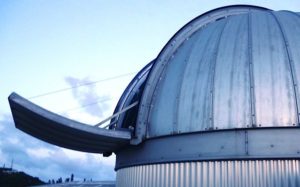
The University of the Virgin Islands’ (UVI) Etelman Observatory has joined an international collaboration of telescopes across the globe focused on studying and understanding the elusive explosions in space that lead to the emission of powerful bursts of gravitational waves. The Global Rapid Advanced Network Devoted to the Multi-messenger Addicts (GRANDMA) collaboration is a worldwide partnership of 25 ground-based telescopes in Europe, Asia, Australia, North America and the Caribbean. The GRANDMA collaboration has recently released its results of the long-haul observation campaign No. 3 (03) aimed at detecting mergers of compact objects like white dwarfs, neutron stars and black holes.
“The involvement of the Etelman Observatory in this international research effort builds on our traditional strength in astrophysics research and is solidifying UVI as a key contributor to the study of gravitational wave sources,” said David Morris, Ph.D., associate professor of physics and director of the Etelman Observatory.
“These gravitational wave sources have only been known about for a few years but are already opening entirely new fields of scientific study and will continue to do so for years to come,” Morris said.
The Etelman Observatory and its staff contributed to the success of this observation campaign by joining the GRANDMA collaboration in September 2019 and offering observation time on the Virgin Islands Robotic Telescope (VIRT). N. Brice Orange, Ph.D., of OrangeWave Innovative Science LLC, who oversees operations at Etelman Observatory, coordinates with GRANDMA to schedule the robotic telescope observations of candidate gravitational-wave events that are carried out at the Etleman Observatory by resident astronomer, Priyadarshini Gokuldass. Morris then processes and investigates these images for the presence of previously unknown sources of light.
“The collaboration provides our physics students a remarkable opportunity to interact in real-time with leading scientists from all over the world and to work on some of the most cutting-edge science being done today,” said Morris. “This important alliance not only contributes to the innovative research in this field but also opens doors for our students as they progress to graduate studies and careers in science.”
During the No. 3 (03) run, the Etelman Observatory worked to further maximize GRANDMA’s hunting of large volumes of the universe for potential gravitational wave signatures by maintaining a near-continuous line of contact with the Zadko Observatory in Western Australia, at nearly the exact opposite side of the Earth from the V.I. Robotic Telescope’s location on St. Thomas.
Despite the valiant efforts of the GRANDMA consortium, which followed-up 90 percent of gravity wave alerts during (03) none of its ground-based telescopes detected light sources from a gravitational wave event. This may hint to sources of gravitational waves being even more elusive than previously expected.
Sarah Antier, Ph.D., GRANDMA spokesperson, said, “these [gravitational wave] events are the ones creating gold in the universe, so it would be really surprising if they happened to be common. Our results clearly show, however, that by globally coordinating observations we can be efficient in chasing them.”
Only a few dozen gravitational wave events have been detected to date. Only one of these events has ever been also detected in light from ground-based telescopes, and the V.I. Robotic Telescope played a role in this historical observation on Aug. 17, 2017. The next round of LIGO-Virgo observations will commence in 2021.
For more information on the GRANDMA initiative, visit https://grandma.lal.in2p3.fr/.
For more information on the V.I. Robotic Telescope, visit https://grandma.lal.in2p3.fr/virt/.
About GRANDMA – The Global Rapid Advanced Network Devoted to the Multi-messenger Addicts (GRANDMA) is a multi-national network of 25 telescopes from 12 countries that seeks to solve the “toy-boat in the ocean” problem of identifying elusive gravitational wave events in the sky by leveraging globally distributed resources focused on time-domain astronomy.
Specifically, by splitting each ocean into small pools and divvying individual chunks of observing to one of its 25 telescopes to investigate for previously unknown sources of light, the network can cover far more sky. In addition, the collaboration has created a public outreach program, the Amateur Kilonova Catcher, that allows anyone with a telescope to contribute even more worldwide astronomical observations and report them.


